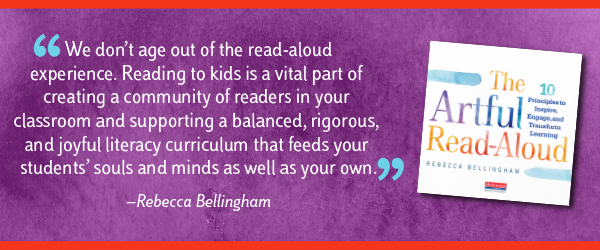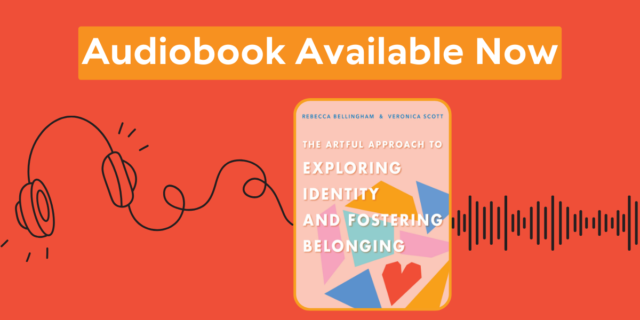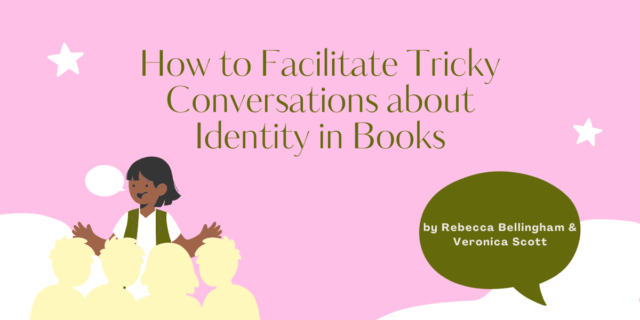
Reading aloud to children every single day is one of the most important things any teacher can do to help children grow and become better readers, better thinkers, and, frankly, better human beings. The more I read to children in classrooms and to teachers and graduate students with whom I work, the more convinced I am that it is one of the most powerful tools we have to raise kids, teach kids, and create compassionate and civil communities.
And yet, many teachers still feel they don’t have enough time to read to their kids. I hear from teachers all the time about the pressures they feel to fit everything in and to make sure everything they are doing meets the standards for quality instructional time. My response to this is always the same. There is virtually nothing you could do that would be more valuable and important than reading aloud every day, not just because kids love it and are able to experience the joy and delight books can provide but also because it fuels their ability and desire to read.
Teaching children how to read is not a simple thing, and every child’s reading journey is unique. There are a few things, however, that are indisputable. Children need rich and varied exposure to books and words and positive experiences with books and reading that set them on a course to become lifelong readers. Young children also need explicit instruction in the technical aspects of print, which includes instruction in phonemic awareness, spelling patterns, and phonics. While this book is obviously not intended to be a primer on how to teach children to read, there is no question that the interactive read-aloud is an essential part of any classroom’s comprehensive literacy curriculum.
Listen to a sample from The Artful Read-Aloud Audiobook
Access
There is little doubt about the importance of reading to young children because it gives them access to sounds, stories, ideas, vocabulary, and information they would otherwise be unable to read on their own. But attitudes often shift once children can decode. People worry, “Shouldn’t kids spend more time reading on their own now that they can read?” Of course, they absolutely should be reading on their own, and we should give them plenty of time to do that work at school and at home. But reading aloud remains essential.
Once children can decode, they still have plenty to do in order to become masterful readers. Reading requires doing many kinds of mental work all at the same time: decoding words, dealing with the print, thinking, imagining, envisioning, predicting, questioning, putting things together, and more. That’s a lot of cognitive work for a young person.
When we read to children, we remove one enormous piece of the cognitive load. We take away the pressures of the print, freeing kids up to think. They can develop their thinking muscles no matter how tricky the text is. Even if they can read complicated text, reading to them still allows them to focus all their energy on the movie in their minds. I listen to audiobooks all the time, and sometimes it is with those books where the picture in my mind is most strong, where I can recall the actions, feelings, or voice of a character with far greater detail and nuance.
Some kids have no trouble decoding words but are fooling us with their fluency. They can read all the words on a page, but they are doing something more like word calling than reading. They wouldn’t be able to retell the important parts, ask thoughtful questions, or imagine the words, actions, or ideas in their brain. For kids to get better at reading, they need to read books that match their independent reading level; books they can read with both accuracy and comprehension. For other kids, what they can read independently doesn’t match the complexity or sophistication of what they can understand, discuss, or think about. Teachers can give all children in their classrooms access to books that they otherwise couldn’t read independently.
And what about the kids who are not able yet to do that difficult decoding work, who struggle even more significantly with the demands of print? Read-aloud is a lifeline to books and stories that would otherwise be out of reach, given the demands of the print. And I say that word in earnest: read-aloud is a lifeline. For all kids. But for those who struggle with reading—and there are a lot of kids who struggle for various reasons—it is often a source of frustration, discomfort, and even shame. By reading aloud to them every day, you are giving all kids access to the magic and beauty and power of story. You are giving them windows and mirrors, stories of hope, resilience, courage, and community that they otherwise might not be able to experience—in the company of one another. And you’re giving every child a powerful sense of reading identity.
But that’s not all. By reading every day in your classroom, you are giving children access to literary conversations and to the ideas and inner worlds of one another. It’s almost impossible not to have literate conversations while reading aloud quality children’s literature to kids. Even just asking kids to pause and tell a neighbor what they are thinking or wondering gives them practice with talking about their reading. And even short conversations and turn-and-talks during a read-aloud have an impact.
Modeling
What we model for kids is what they remember most. Reading aloud is the most effective way to model for students what real reading looks and sounds like. How else can we show students what the invisible processes of reading and thinking look like? How else can students hear what it sounds like to read fluently, expressively, and in a way that allows you to really see and understand what’s happening? How can we model the love we have for books unless we actually show kids our genuine reactions, enthusiasm, and experience of reading real books? I think it’s safe to say that most teachers go into teaching because they wanted to help raise a generation of kids who would be lifetime readers, not just schooltime readers who only read because it was an assignment.
Interactive read-alouds also make it possible to explicitly model comprehension skills that powerful readers need to utilize in order to gain real understanding. By thinking aloud, we are modeling the way we put together the threads of a book, think carefully about characters, and get the picture clear in our minds. By voicing our confusion about a word or complicated part, we are explicitly demonstrating what proficient readers do when they encounter trouble. By modeling the whole host of comprehension strategies strong readers use as they move through a text, we are modeling authentically—in the context of a real book, not a prefabricated passage that is designed for the practice of strategies in isolation. The modeling that occurs in the context of reading aloud demonstrates an orchestration of strategies that readers use on the fly, all at once, as we read. When we read books, we don’t decide to only envision, predict, or infer.
There is another, equally important, kind of modeling that reading aloud affords, especially for big kids who are beginning to face bigger decisions and challenges—the modeling of compassion, kindness, and openheartedness. Contemporary children’s and young adult literature tackles issues that children are facing today: the effects of intolerance, bullying, and racism, as well as war, displacement, and other humanitarian crises. We are in an ever-changing world with ever-expanding and overwhelming access to information. Our children must learn to navigate the pull of various screens and devices. Reading a book together with a group of children makes it possible to quiet and focus our screen-obsessed brains, to gather together around a story that shines a light on any number of big issues, and to show up for one another. When we go on a journey with a character who’s navigating tough situations that many of our kids are facing, we are able to give space for honest discussion and model careful listening. We can model compassion not only for the characters in the stories but for one another. Reading aloud can help make our classrooms kinder, more generous places, which provide a model for the kind of world we are all trying to create.
Joy
If you’ve ever read to a child or a group of children, you’ve probably noticed they seem to enjoy it. A lot. Feeling engaged and swept away by a great story is deeply pleasurable. I feel that reading aloud is one of the best things about being a teacher and a child in a classroom, not only because it fuels kids’ reading lives but because it fills kids (and teachers!) up with joy. And that is not to be underestimated.
Joy is serious business. I think we should be talking more about the importance of joy in our classrooms. Quite simply, we are more productive, more engaged, and more open to learning when we are happy. Lots of serious folks in the world of business are looking closely at the role of happiness at work and the impact it has on the bottom line. It isn’t too far a leap to wonder about the role of happiness at school and the impact it has on students.
So, where does read-aloud fit in to all this? In the simplest terms, read-aloud makes kids happy. It’s a surefire way to create moments of joy at school, which creates the conditions for kids to do their best learning.
If kids don’t experience the joy in reading, how can we expect them to see the point? If the bulk of their experiences with reading are painful or tedious, how will they grow into lifelong readers? Creating joyful learning and reading experiences is not fluff because kids who love to read, read more. And kids who read more do better in school and (because it’s a reality we have to face . . .) do better on tests.
We don’t age out of the read-aloud experience. Reading to kids is a vital part of creating a community of readers in your classroom and supporting a balanced, rigorous, and joyful literacy curriculum that feeds your students’ souls and minds as well as your own.
To learn more about The Artful Read-Aloud visit Heienmann.com. 
 Rebecca Bellingham is a teacher, literacy consultant, college instructor, and performer. After receiving her master's in elementary education at Lesley University through Shady Hill School's Teacher Training course, Rebecca began working as a teaching artist in the South Bronx with DreamYard, a nationally recognized community arts organization. She went on to teach at the Berkeley Carroll School in Park Slope, where she was a fourth-grade teacher and literacy coach. She received a master's degree in literacy specialization at Columbia University Teachers College and began working at Teachers College Reading and Writing Project as a staff developer and later as a full time instructor in the Literacy Specialist program. Currently, Rebecca leads professional development within the San Diego Unified School District, partners with many nonprofit, arts-based and literacy organizations, and continues to teach courses on the integration of the arts and literacy at Teachers College. As an actress and singer, Rebecca has performed in numerous off-broadway and regional theaters around the country.
Rebecca Bellingham is a teacher, literacy consultant, college instructor, and performer. After receiving her master's in elementary education at Lesley University through Shady Hill School's Teacher Training course, Rebecca began working as a teaching artist in the South Bronx with DreamYard, a nationally recognized community arts organization. She went on to teach at the Berkeley Carroll School in Park Slope, where she was a fourth-grade teacher and literacy coach. She received a master's degree in literacy specialization at Columbia University Teachers College and began working at Teachers College Reading and Writing Project as a staff developer and later as a full time instructor in the Literacy Specialist program. Currently, Rebecca leads professional development within the San Diego Unified School District, partners with many nonprofit, arts-based and literacy organizations, and continues to teach courses on the integration of the arts and literacy at Teachers College. As an actress and singer, Rebecca has performed in numerous off-broadway and regional theaters around the country.
You can find her online at RebeccaBellingham.com and on Twitter @beckybellingham



